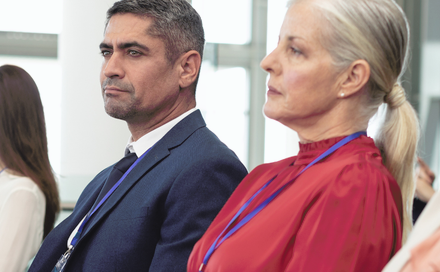In this second of three articles, John Scarrott shares insights and ideas on Preparing, Performing and Personal Growth for chairs and facilitators - a useful read, whether you’re about to volunteer or if you have some experience. Chairing and Facilitating at Conferences
John Scarrott, Communications Skills Trainer and Coach, and an AAE trainer, spoke with Barbara Grobicki, Executive Director of the . The Strategic Management Society, Linda Pereira, CEO of CPL Events & Chair of many associations and Lisa Collins, Managing Director of Dovetail Creative and former Head of Membership Engagement at IABM.
Part 2: Performing Well - It’s all about the energy in the room
You’ve prepared to chair or facilitate well. On paper, you’re ready. But when you ‘go live’, a critical part of your role is managing the energy in the room. I spoke with Lisa Collins, Managing Director of Dovetail Creative, Linda Pereira, CEO of CPL Events and Barbara Grobicki, Executive Director, The Strategic Management Society. They shared their ideas for spotting and managing energy levels to create good engagement and a positive event experience.
Energy dips and energy creation

For Linda Pereira, the energy at your event is all important. That is what delegates will remember and what will create and sustain their contributions. “My goal is to start on a high and end on a high. I do some sense checks as my speakers are talking. I ask ‘What’s my feeling on the direction the energy is going? Is it dipping, on the up or sustained?’ Walking to the back of the room gives me a feeling for how much engagement is taking place.”
Barbara Grobicki also recommends being mobile. “As a facilitator I won’t serve my group best by staying on the raised stage away from the participants. l want to be in amongst them. This helps guide me towards what I want to be saying and doing to create the right experience.”
A willingness to move yourself around room helps you to notice energy dips and energy creation. For Pereira, “if people are picking up their phones, or sitting back, these are signs of potential energy dips. If people are sitting forward, nodding, making a note, leaning over to speak with their neighbour on the table, if there is a murmur in the room. All of these are signs that there is energy in the room.”
Your welcome
This begins at the door. Pereira recommends you welcome your participants as they come in. She advises “Stand at the door as they’re coming in, say, ‘hello and welcome and thank you for coming’. This says ‘I value each and every one of you’.
Your warm up
Icebreakers are very useful to raise the level of energy and create a sense of warmth in the room. Grobicki describes how she “had the tables introduce each other briefly and share their answers to ‘What was your first rock concert?’ Then the tables chose a ‘winner’ and each reported back. We then voted on an overall choice at the end as a favourite. It was fun, there was a woman there who saw the Beatles!”
Your introductions
Pereira recommends making your speaker introductions “more than just a ‘blah’ introduction. Your words should connect the speaker to the audience, and the audience to the speaker. Bring them closer to each other, and you make for a great session.”
Your post speaker, thank you
Your role is to celebrate the speaker, whatever effect they have on the room. Periera suggests picking out something specific that you found to be noteworthy. “You might say ‘Wow, wasn’t that an interesting/amazing/insightful (pick the positive term that fits for you) talk, presentation. I found X and Y to be of particular note. Maybe you were the same or you found something else to ponder. I’m looking forward to your questions later.’”
Restart after lunch

Lisa Collins has some advice for maintaining energy levels after lunch. “I might ask them about the morning’s sessions and for any highlights. Someone will share something and that will get the room going. To invite them to get involved, I use certain devices, such as ‘raise your hands if’. I might also select someone who looks like they want to contribute.”
Good endings
Periera suggests also being present as the delegates are leaving. “Thanking them as they leave says ‘I appreciate your attention and contribution.’ Be a proper host, adapt your tone and approach to each opportunity to suit the participants.”
Managing curve balls
During a session, assume you might be thrown a surprise that can potentially affect the energy of the session. That way, you’ll be ready to act to stop it from derailing the session. Collins has first-hand experience of this. “At a recent event, someone shared a view that was in firm opposition to what I had just shared. I engaged them on it, and it became apparent that they were sticking to their point of view. I could see it was taking us off course. I suggested we move on, and that I would be very happy to explore the subject with the delegate over coffee. The session moved on, and we met afterwards to continue the discussion. Everyone was happy.”
A final flourish: tipping your hat to the audience and the organiser
In your role as a Chair or Facilitator, you might consider yourself a part of the event. With this in mind, it’s worthwhile thinking about any small creative touches that will align you with the event and the participants. Pereira shares some examples, “I have been known to paint my nails in the organiser’s brand colours. When I’ve chaired an event for software engineers, I’ve worn sneakers, combined with whatever I've chosen to wear. In both cases, it’s a nod to them. It says ‘I see you’, without giving up my own sense of style. And that’s key to connecting with them.”
A huge thank you to Lisa Collins, Linda Pereira and Barbara Grobicki for taking the time to share your experience and insights
Thanks for reading, and happy chairing and facilitating
John Scarrott is a trainer and coach specialising in the areas of presentations, conference speaking, chairing and facilitation. He offers bespoke training workshops to associations that want to support members to perform well at their events.
John provides in-house training to associations. View the training here.
You can find out more about John at www.johnscarrott.com and at LinkedIn and at [email protected]

